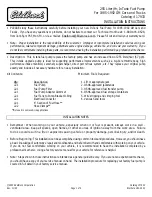
Consumer information and Reporting safety defects/Tire information
&
Tire care
–
maintenance and
safety practices
.
Check on a daily basis that the
tires are free from serious damage,
nails, and stones. At the same time,
check the tires for abnormal wear.
.
Inspect the tire tread regularly
and replace the tires before their
tread wear indicators become visi-
ble. When a tire
’
s tread wear
indicator becomes visible, the tire
is worn beyond the acceptable limit
and must be replaced immediately.
With a tire in this condition, driving
at even low speeds in wet weather
can cause the vehicle to hydro-
plane. Possible resulting loss of
vehicle control can lead to an
accident.
.
To maximize the life of each tire
and ensure that the tires wear
uniformly, it is best to rotate the
tires every 7,500 miles (12,000 km).
For information about the tire rota-
tion order, refer to
“
Tire rotation
”
F
11-25.
Replace any damaged or
unevenly worn tires at the time of
rotation. After tire rotation, adjust
the tire pressures and make sure
the wheel nuts are correctly tigh-
tened. For information about the
tightening torque and tightening
sequence for the wheel nuts, refer
to
“
Flat tires
”
F
9-6.
&
Determining compatibility of
tire and vehicle load capaci-
ties
The sum of four tires
’
maximum
load ratings must exceed the max-
imum loaded vehicle weight
(
“
GVWR
”
). In addition, sum of the
maximum load ratings of two front
tires and of two rear tires must
exceed each axle
’
s maximum
loaded capacity (
“
GAWR
”
). Original
equipment tires are designed to
fulfill those conditions.
The maximum loaded vehicle
weight is referred to Gross Vehicle
Weight Rating (GVWR). And each
axle
’
s maximum loaded capacity is
referred to Gross Axle Weight Rat-
ing (GAWR). The GVWR and each
axle
’
s GAWR are shown on the
vehicle certification label located at
the bottom of driver
’
s side door
pillar.
The GVWR and front and rear
GAWRs are determined by not only
the maximum load rating of tires but
also loaded capacities of the vehi-
cle
’
s suspension, axles and other
parts of the body.
Therefore, this means that the
vehicle cannot necessarily be
loaded up to the tire
’
s maximum
load rating on the tire sidewall.
&
Adverse safety conse-
quences of overloading on
handling and stopping and
on tires
Overloading could affect vehicle
handling, stopping distance, and
vehicle and tire performance in the
following ways. This could lead to
an accident and possibly result in
severe personal injury.
.
Vehicle stability will deteriorate.
.
Heavy and/or high-mounted
13-10
Summary of Contents for Crosstrek 2022
Page 1: ...2017 OWNER S MANUAL Impreza Love It s what makes a Subaru a Subaru...
Page 2: ......
Page 4: ......
Page 5: ...Vehicle types This manual describes the following vehicle types 1 Sedan 2 5 door models...
Page 6: ......
Page 16: ......
Page 102: ......
Page 104: ...Keys and doors Moonroof if equipped 2 37 Moonroof switches 2 38 Sun shade 2 39...
Page 142: ......
Page 234: ......
Page 248: ......
Page 252: ......
Page 332: ......
Page 368: ......
Page 376: ......
Page 424: ......
Page 460: ......
Page 461: ...Index 14...
Page 472: ......
Page 473: ......
Page 474: ......
















































